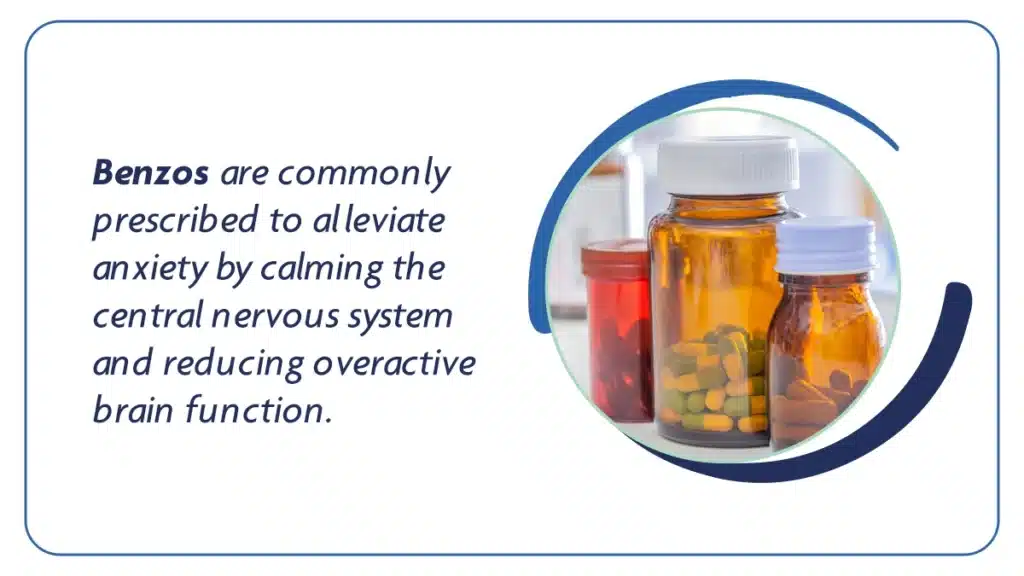Benzos are a class of psychoactive drugs widely prescribed for their anxiolytic, soothing, and muscle relaxant properties. Primarily utilized to alleviate anxiety disorders, panic attacks, and insomnia, benzodiazepines act on the central nervous system, enhancing the effect of a neurotransmitter called gamma-aminobutyric acid (GABA).
This increased GABA activity leads to a calming effect on the brain, promoting relaxation and reducing excessive neural activity. Despite their efficacy, the use of benzodiazepines is often carefully monitored due to the potential for dependence and addiction.
Understanding their therapeutic applications is vital for ensuring safe and effective use in medical contexts.
Key Takeaways
Benzodiazepines can be effective for short-term management of certain conditions, but their long-term use poses potential risks of adverse effects. Here’s what you need to know:
- Benzos are commonly prescribed to alleviate anxiety by calming the central nervous system and reducing overactive brain function.
- These medications are also used as sedatives, muscle relaxants, and for managing symptoms of alcohol withdrawal.
- Caution is advised in benzos use due to the potential for adverse effects, dependence, and overdose risk.
Contact us at (845) 479-6888 for more information and personalized drug recovery assistance for your teen’s healthier tomorrow.

What are Benzos
Benzos, short for benzodiazepines, are a class of medications commonly prescribed to treat anxiety, insomnia, and certain neurological conditions. They work by enhancing the effects of a neurotransmitter called gamma-aminobutyric acid (GABA), which has a calming effect on the brain.
Benzos can induce relaxation and sedation, making them effective in managing acute anxiety or sleep disorders. However, they come with potential risks, including dependency and withdrawal symptoms. Prolonged use may lead to tolerance, requiring higher doses for the same effect.
Using benzos under medical supervision is important to balance their benefits and minimize potential adverse effects.
Types of Benzodiazepines
Benzos can be classified into short-acting and long-acting categories based on their duration of action. It’s important to note that these medications should be used under the guidance and prescription of a qualified healthcare professional, as they can be habit-forming and may have potential side effects.
Short-Acting Benzodiazepines
Examples of short-acting benzos include:
- Alprazolam (Xanax): This is often prescribed for anxiety and panic disorders. It has a relatively short duration of action.
- Lorazepam (Ativan): Used for anxiety and as a preanesthetic to reduce anxiety. It has a shorter duration compared to some other benzos.
- Triazolam (Halcion): Primarily prescribed for insomnia. It has a rapid onset of action but a short duration.
Long-Acting Benzodiazepines
Examples of long-acting benzos include:
- Diazepam (Valium): Used for anxiety, muscle spasms, and as a preanesthetic. It has a longer duration of action compared to some other benzos.
- Clonazepam (Klonopin): Prescribed for various seizure disorders, panic disorders, and certain types of movement disorders. It has a longer half-life compared to some shorter-acting benzos.
- Chlordiazepoxide (Librium): Used for anxiety and alcohol withdrawal. It has a longer duration of action.
The classification into short-acting and long-acting benzos helps doctors tailor treatment plans to individual needs. Short-acting benzos may be preferred for conditions requiring rapid relief.
In contrast, long-acting ones might be chosen for more sustained effects, especially in the treatment of chronic conditions like generalized anxiety disorder. Always consult with a healthcare provider for advice specific to your situation.
Medical Uses of Benzodiazepines
Healthcare professionals should carefully monitor the use of benzodiazepines due to the potential for dependence and other adverse effects.
Here are some of the medical uses of benzodiazepines:
Anxiety
Benzodiazepines are commonly prescribed to alleviate symptoms of anxiety disorders. They enhance the activity of gamma-aminobutyric acid (GABA), a neurotransmitter that inhibits brain activity.
This results in a calming effect, helping patients manage excessive worry, tension, and other manifestations of anxiety.
While benzos provide rapid relief, their use is often limited due to the risk of dependence and potential side effects, making them a short-term solution for acute anxiety episodes.
Sleep Disorders
Insomnia and other sleep disorders are frequently treated with benzodiazepines. By promoting relaxation and sedation, benzos assist young adults in falling asleep and maintaining a healthy sleep cycle.
However, their long-term use is generally discouraged due to the risk of developing tolerance and dependence, which can lead to rebound insomnia upon discontinuation. Non-benzodiazepine alternatives are often considered for more sustainable sleep management.
Seizures
Benzo plays a crucial role in managing seizures, particularly in emergencies. The rapid onset of action makes them effective in halting acute seizure episodes. Drugs like diazepam and lorazepam are administered intravenously in hospital settings to provide swift relief and prevent prolonged or recurrent seizures.
Their anticonvulsant properties contribute to the overall treatment strategy for individuals with epilepsy.
Alcohol Withdrawal
In cases of alcohol dependence and withdrawal, long-acting benzodiazepines are commonly employed to mitigate symptoms and prevent severe complications such as delirium tremens. By calming the hyperactivity of the central nervous system, benzos help manage the anxiety, tremors, and seizures associated with alcohol withdrawal.
However, careful monitoring is essential due to the potential for cross-dependence, where individuals may substitute one substance (alcohol) with another (benzodiazepines).
Anesthesia
Benzos find application in anesthesia, where their sedative and muscle relaxant properties are valuable. These illicit drugs are often used in combination with other anesthetic agents to induce a state of unconsciousness, amnesia, and muscle relaxation during surgical procedures.
The precise dosage and administration are carefully tailored to each patient, ensuring a safe and controlled anesthetic experience.
Risks and Side Effects
Benzos can effectively manage certain conditions, but they also come with risks and potential side effects, especially with long-term use. It’s important to note that individual responses to benzos can vary, and not everyone will experience the same effects.
Here are some common side effects of benzodiazepines:
Common Side Effects
Sedation and Drowsiness: Street benzos can cause drowsiness and impair cognitive function.
Dizziness and Ataxia: Users may experience problems with coordination and balance.
Memory Impairment: Benzos can affect short-term memory and concentration.
Muscle Weakness: Some people may experience muscle weakness or fatigue.
Tolerance: Over time, the body may become tolerant to the effects, requiring higher doses for the same result.
Risks of Long-term Use
Cognitive Impairment: Prolonged use can lead to persistent cognitive decline and memory issues.
Increased Fall Risk: The sedative effects can contribute to a high risk of falls, particularly in older people.
Dependency and Addiction: Long-term benzodiazepines use increases the risk of developing a physical and psychological dependence on the tablets.
Withdrawal Symptoms: Abruptly stopping benzodiazepine receptors or reducing the dosage after long-term use can lead to withdrawal symptoms.
Risk of Dependency: Regular use of benzodiazepines can lead to physical dependence, and people may develop a psychological reliance on the medication for managing stress or anxiety.
Withdrawal Symptoms
Rebound Anxiety: Anxiety symptoms may worsen temporarily after stopping the medication.
Insomnia: Difficulty sleeping is a common withdrawal symptom.
Irritability and Mood Changes: Mood swings, irritability, and emotional instability may occur.
Nausea and Vomiting: Gastrointestinal symptoms such as nausea and vomiting can occur.
Sweating and Tremors: Physical symptoms like sweating, tremors, and paranoia may be present.
Seizures: In some cases, withdrawal can lead to seizures, especially if the drug is discontinued abruptly.
Risk of Overdose
Widespread use of benzos or combining it with other central nervous system depressants (e.g., alcohol) can lead to respiratory depression, overdose, and even death.
It’s crucial for individuals prescribed benzos to use substances as directed by their healthcare providers, and any concerns about side effects, dependence, or withdrawal should be discussed with a healthcare professional to receive medical advice.
Abruptly stopping benzodiazepines without medical supervision can be dangerous and should be avoided. If you or someone you know is experiencing difficulties with benzodiazepine use, seeking professional help is recommended.
Frequently Asked Questions (FAQ)
What are the most common benzodiazepines?
Common benzodiazepines include diazepam (Valium), lorazepam (Ativan), alprazolam (Xanax), clonazepam (Klonopin), and temazepam (Restoril). These medications are often prescribed to treat anxiety, insomnia, and certain seizure disorders.
However, they carry the risk of dependence and withdrawal, and healthcare professionals should closely monitor their use to minimize potential adverse effects.
What are benzodiazepines, and how do they work?
Benzodiazepine sedatives enhance the activity of gamma-aminobutyric acid (GABA), a neurotransmitter that inhibits brain activity. By binding to specific receptors on neurons, benzos increase the inhibitory effects of GABA, leading to a calming or soothing effect.
This mechanism makes benzodiazepines effective in treating conditions, for example, anxiety, insomnia, and seizures. However, their use is associated with the risk of dependence and withdrawal.
What are the differences between all benzodiazepines?
Benzodiazepines vary in potency, duration, and specific effects. Examples include short-acting ones like alprazolam (Xanax) for rapid relief of anxiety and longer-acting ones like diazepam (Valium) for sustained sedation.
In addition, some, like lorazepam (Ativan), are intermediate. Clonazepam (Klonopin) is used for certain seizure disorders. While sharing a common mechanism of action, individual differences in onset, half-life, and clinical applications distinguish benzodiazepines.
Choosing the right one depends on the patient’s needs and health conditions.
Assisting Teens for a Healthier Tomorrow
Take the first step towards reclaiming your teenager’s life with our dedicated teen treatment center. Our experienced professionals provide a supportive environment where teens can rebuild their lives, fostering growth and resilience.
Our residential treatment program utilizes a combination of evidence-based therapies, including music, art, educational workshops, and recreational activities to guide teenagers toward effective recovery from Benzodiazepine addiction.
Let us partner in your teen’s journey to a healthier future. Contact us at (845) 479-6888 today for more information.

